SUBFAMILY DORYLINAE - Subgenus Anomma males
| The Ants of
Africa SUBFAMILY DORYLINAE - Subgenus Anomma males |
|
| Subgenus Anomma introduction |
Note - I have placed Dorylus atratus Smith in the subgenus Dorylus.
| 1 |  Brown
winged males; with exceptional convexity to anterior of the face Brown
winged males; with exceptional convexity to anterior of the face |
2 |
| . |  Smoky
grey wings Smoky
grey wings |
6 |
| . | Brown winged males; with exceptional convexity to anterior of the face | . |
| 2 |  head
viewed from above with a flat anterior head
viewed from above with a flat anterior |
3 |
| . | 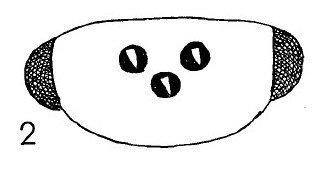 Head
viewed from above with evenly convex anterior border Head
viewed from above with evenly convex anterior border |
4 |
| 3 |  Bigger
grey-brown wings; head viewed from above with a flat anterior Bigger
grey-brown wings; head viewed from above with a flat anterior |
' |
| . | 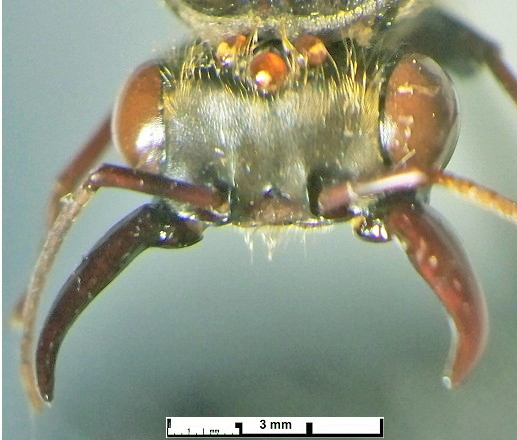 |
West Africa & Congo Basin - funereus |
| . | TL 28-30 mm, HW 5.4, alitrunk width 6.4, gaster width 6.5; head, base of mandibles, femora black; alitrunk and gaster blackish, rest of appendages dark red brown, extreme borders of gaster reddish brown; pubescence yellowish-grey, very fine and very close yellow, even though it is dense the base colour is still visible; wings a little duller than the type; head wider and slightly less convex than zumpti; ocelli smaller and slightly further apart but the distance from the outer edge of the lateral ocelli to the eyes is slightly bigger; mandibles longer than nigricans | Zaïre - funereus
v stygis |
| 4. |
Alitrunk with fine fawn pubescence giving a silky appearance |
5 |
| -- | 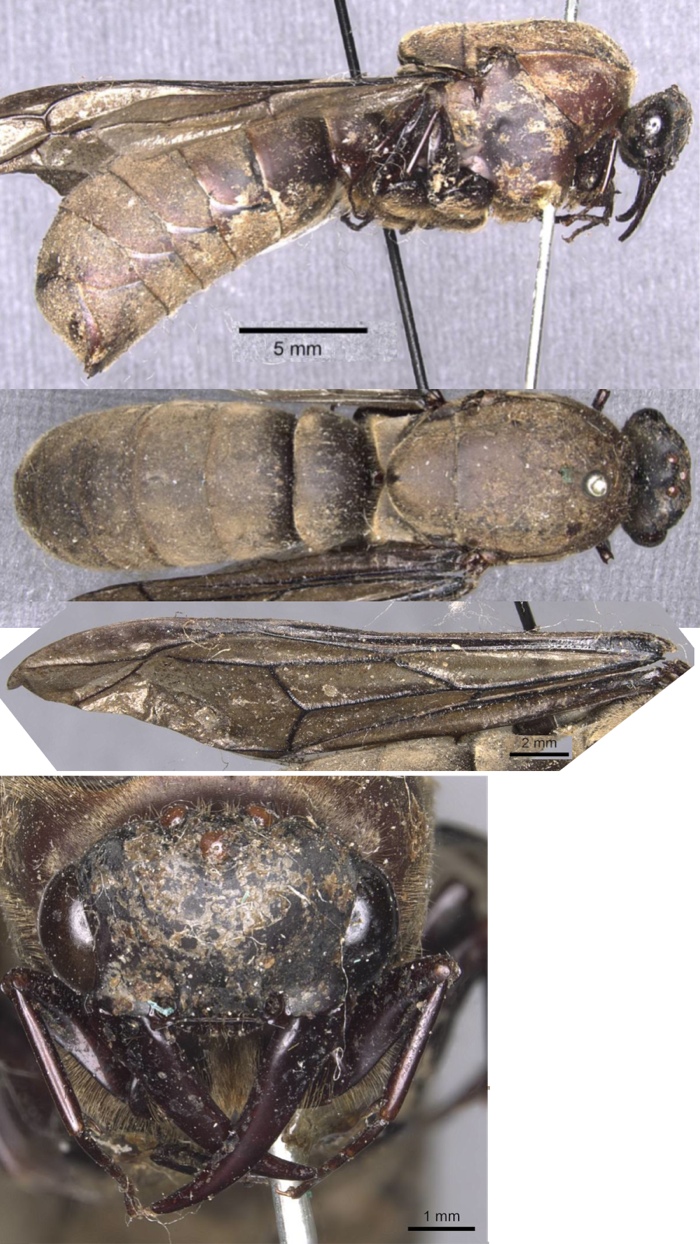 Similar colour to zumpti but with longer
more raised pubescence; Forel (1909b) described the male of emeryi
"(stanleyi ?n.sp...?)" in comparison with nigricans. TL
28-30 mm; HW 4.8, PW 6.6, gaster width 6.4; head with vertex near flat,
slightly convex between the eyes. Frontal carinae less prominent, space
between less concave; whole of head flatter, eyes smaller. Propodeal
dorsum longer; petiole node larger; gaster slightly enlarged
posteriorly, but less than in subgenus Rhogmus. Legs shorter.
Wings darker brown. Pubescence less on thorax, less dense and more
woolly, resembling grey brown felt. Specimen from Zaïre, Katanga,
Mawambi, by Lemaire; rather bigger than type of emeryi. Similar colour to zumpti but with longer
more raised pubescence; Forel (1909b) described the male of emeryi
"(stanleyi ?n.sp...?)" in comparison with nigricans. TL
28-30 mm; HW 4.8, PW 6.6, gaster width 6.4; head with vertex near flat,
slightly convex between the eyes. Frontal carinae less prominent, space
between less concave; whole of head flatter, eyes smaller. Propodeal
dorsum longer; petiole node larger; gaster slightly enlarged
posteriorly, but less than in subgenus Rhogmus. Legs shorter.
Wings darker brown. Pubescence less on thorax, less dense and more
woolly, resembling grey brown felt. Specimen from Zaïre, Katanga,
Mawambi, by Lemaire; rather bigger than type of emeryi. |
Zaïre , Kenya & Uganda
-
stanleyi |
| 5 | 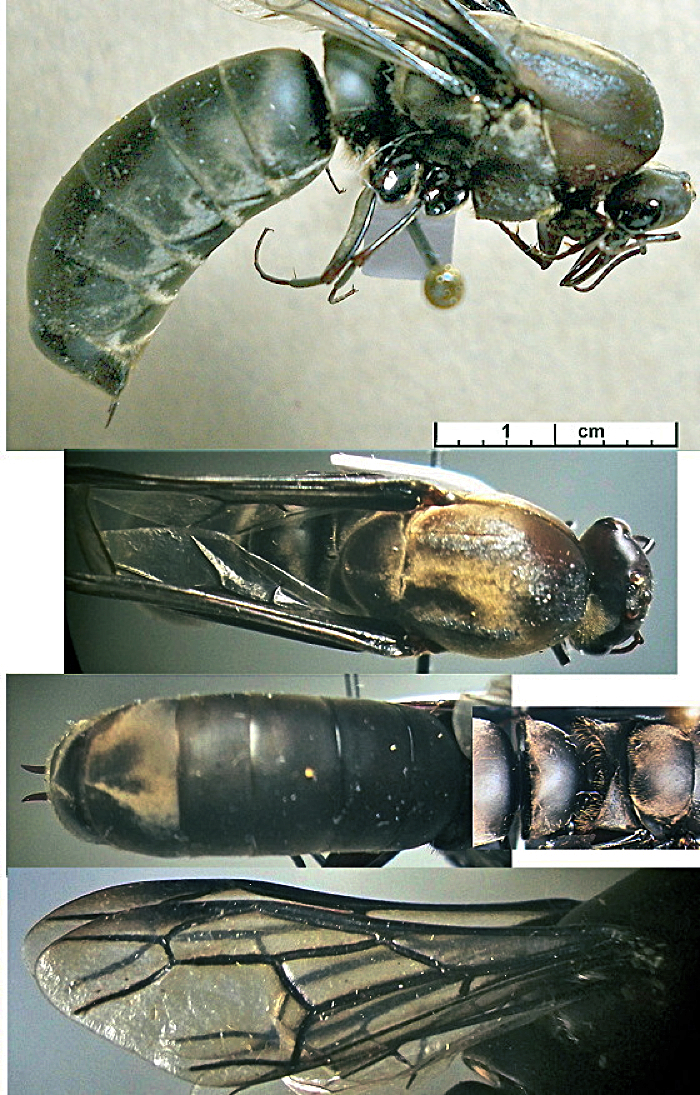 TL
28-33 mm; HW 5.3 mm, alitrunk width 6-6.3 mm, middle of gaster 6 mm;
head & alitrunk dark red brown to black, gaster blackish brown;
alitrunk with fine fawn pubescence giving a silky appearance, much more
spaced on head and gaster; posterior border of petiole straight TL
28-33 mm; HW 5.3 mm, alitrunk width 6-6.3 mm, middle of gaster 6 mm;
head & alitrunk dark red brown to black, gaster blackish brown;
alitrunk with fine fawn pubescence giving a silky appearance, much more
spaced on head and gaster; posterior border of petiole straight |
. |
| . | 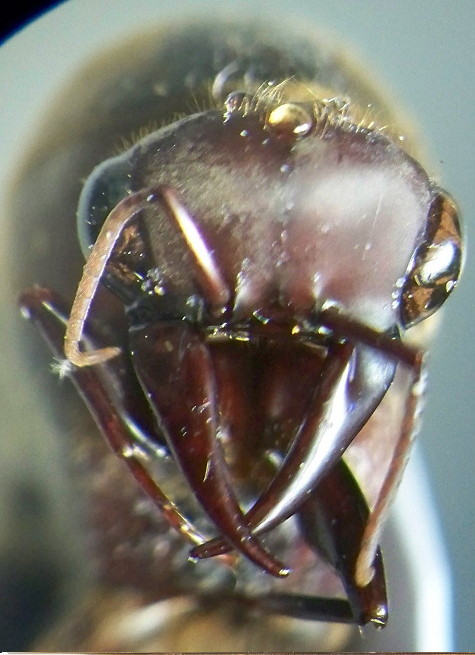 |
zumpti - new status |
| Smoky (light grey) winged males | . | |
| 6 | 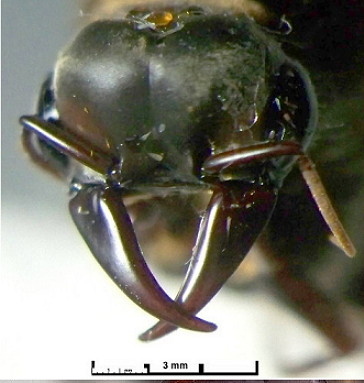 Head
with a distinct longitudinal median sulcus Head
with a distinct longitudinal median sulcus |
7 |
| -- | 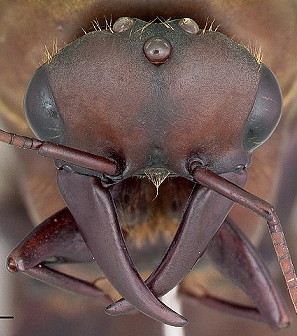 Head
without a distinct longitudinal median sulcus Head
without a distinct longitudinal median sulcus |
10 |
| 7 |  Head from above narrow Head from above narrow |
8 |
| -- | 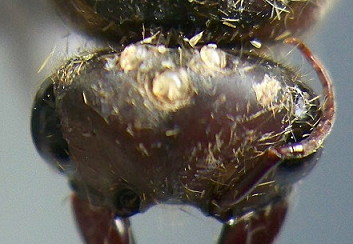 Head from above wide Head from above wide |
9 |
| 8 |  Santschi
(1937b) noted - these males are much duller than those of the race burmeisteri,
the wings are clear, except for the radial cell, but the nerves are
blackish (Forel, 1909b, gave HW 5 mm, PW 6, gaster width 5.6 mm); the
original description gave "Schwärzliche Aemsenwespe [blackish wasp],
nigricans, brunneo-holo-sericeus, abdominis petiolo acetabuliformi.
Lange : Einen Zoll [ca TL 25 mm] bis einen Zoll und drei Linien [TL
28.4 mm]". The specimen was a little bigger than the already known
species Dorylus (Dorylus) helvolus and without hairs; the wings
of nigricans were smoky black with black veins. Posterior
border of petiole concave Santschi
(1937b) noted - these males are much duller than those of the race burmeisteri,
the wings are clear, except for the radial cell, but the nerves are
blackish (Forel, 1909b, gave HW 5 mm, PW 6, gaster width 5.6 mm); the
original description gave "Schwärzliche Aemsenwespe [blackish wasp],
nigricans, brunneo-holo-sericeus, abdominis petiolo acetabuliformi.
Lange : Einen Zoll [ca TL 25 mm] bis einen Zoll und drei Linien [TL
28.4 mm]". The specimen was a little bigger than the already known
species Dorylus (Dorylus) helvolus and without hairs; the wings
of nigricans were smoky black with black veins. Posterior
border of petiole concave |
. |
| . | 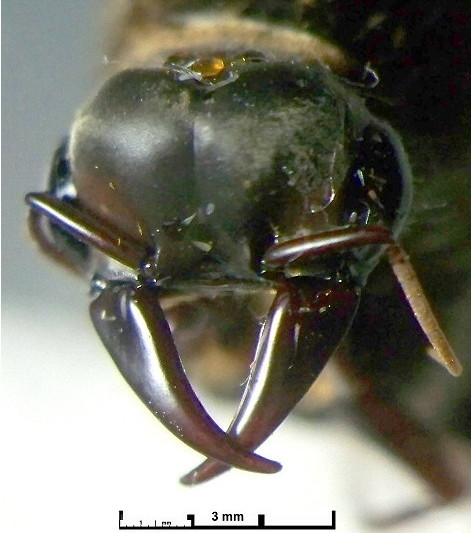 |
West Africa, Congo Basin, and north-east into Sudan and Somalia - nigricans |
| 9 |  Head from
above wide Head from
above wide |
. |
 |
Central African Republic - new species - bayangaensis | |
| Head without a distinct longitudinal median sulcus | . | |
| 10 | Occiput with no more than a few short erect hairs | 11 |
| -- | Occiput with quite abundant erect hairs | 12 |
| 11 | 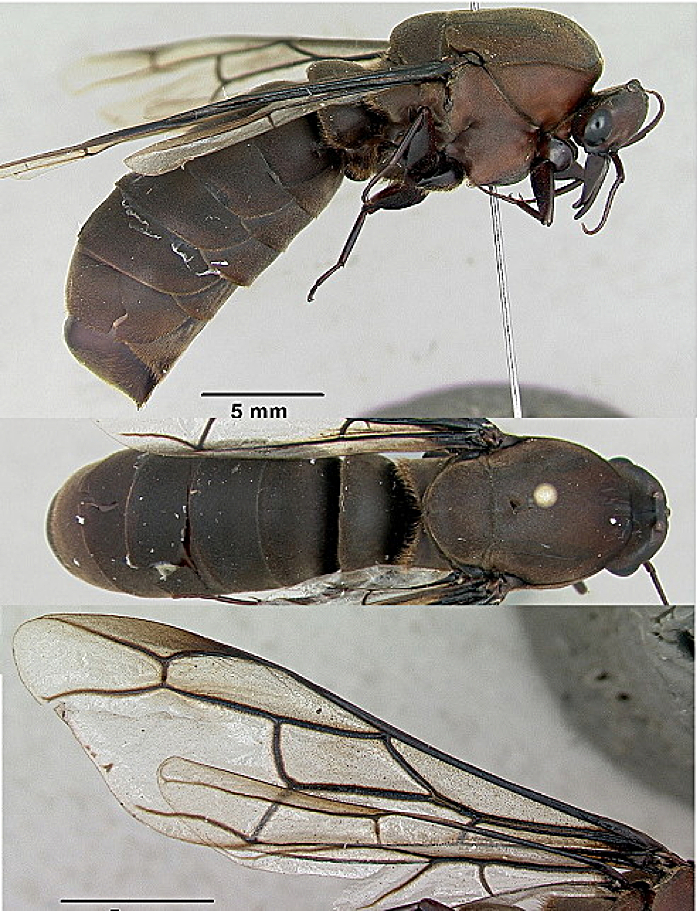 |
. |
| . | 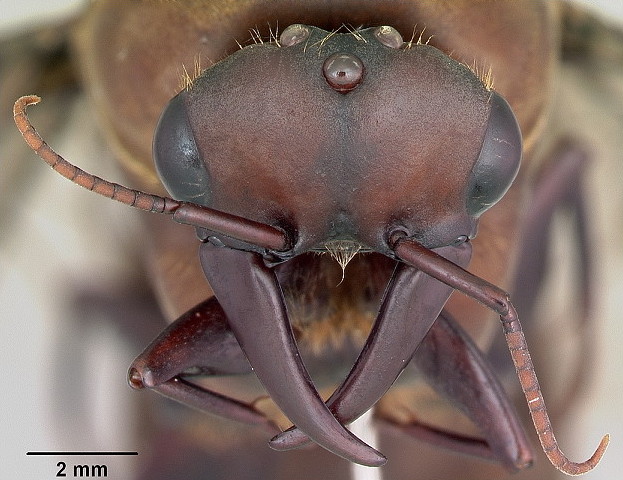 |
West Africa, Congo Basin and ? East Africa - burmeisteri |
| Occiput with quite abundant erect hairs | . | |
| 12 | Occiput with short erect hairs | 13 |
| -- | Occiput with long erect hairs | 14 |
| 13 |
|
. |
| . | 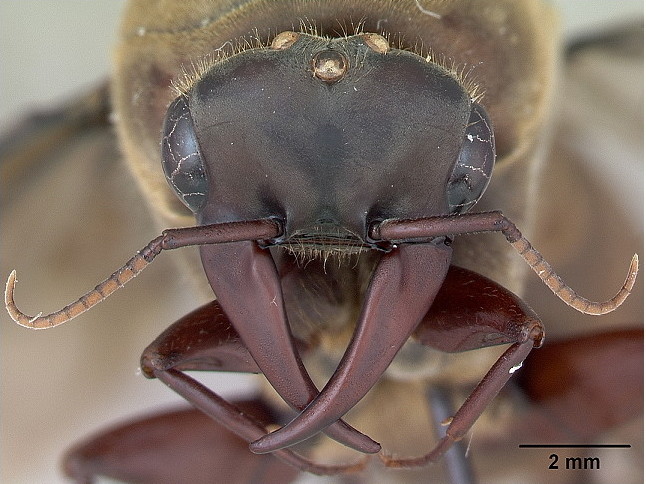 |
West Africa & Congo Basin - wilverthi |
| Occiput with long erect hairs | . | |
| 14 | 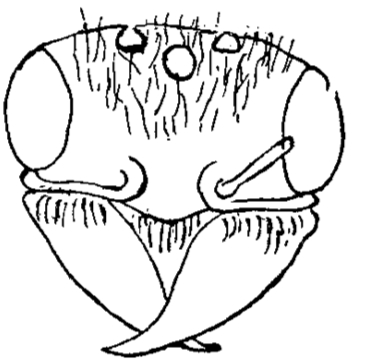 (Santschi 1912b) TL 28 mm,
reddish brown, head blackish, appendages brown red; with long
undulating blond hairs covering all the space between the eyes and the
frontal crests, from the clypeus to the occiput, with another tuft of
hairs inserted on the base of the mandibles; other such long hairs on
the base of the propodeum, under the alitrunk and on the femorae;
alitrunk and gaster covered with a silky golden pubescence as on depilis.
Head twice as wide as high much less high than in nigricans
(sic) with a much flatter upper border but much more arcuate than with atratus.
Eyes as convex and and raised as in atratus. Mandibles only
three times as long as the bases are wide (much wider in atratus).
First two segments of the funiculus smooth and shiny; scape shorter
than in nigricans. Alitrunk longer and narrower than nigricans,
with the scutellum narrower posteriorly. Petiole "cupuliforme" shorter
than nigricans. Wings yellow or a little brownish, with brown
nerves; anterior wing 19 mm; HW 5.1 mm height of head 2.3 mm, alitrunk
width 5 mm. (Santschi 1912b) TL 28 mm,
reddish brown, head blackish, appendages brown red; with long
undulating blond hairs covering all the space between the eyes and the
frontal crests, from the clypeus to the occiput, with another tuft of
hairs inserted on the base of the mandibles; other such long hairs on
the base of the propodeum, under the alitrunk and on the femorae;
alitrunk and gaster covered with a silky golden pubescence as on depilis.
Head twice as wide as high much less high than in nigricans
(sic) with a much flatter upper border but much more arcuate than with atratus.
Eyes as convex and and raised as in atratus. Mandibles only
three times as long as the bases are wide (much wider in atratus).
First two segments of the funiculus smooth and shiny; scape shorter
than in nigricans. Alitrunk longer and narrower than nigricans,
with the scutellum narrower posteriorly. Petiole "cupuliforme" shorter
than nigricans. Wings yellow or a little brownish, with brown
nerves; anterior wing 19 mm; HW 5.1 mm height of head 2.3 mm, alitrunk
width 5 mm. |
West Africa & Congo Basin - opacus |
| -- | 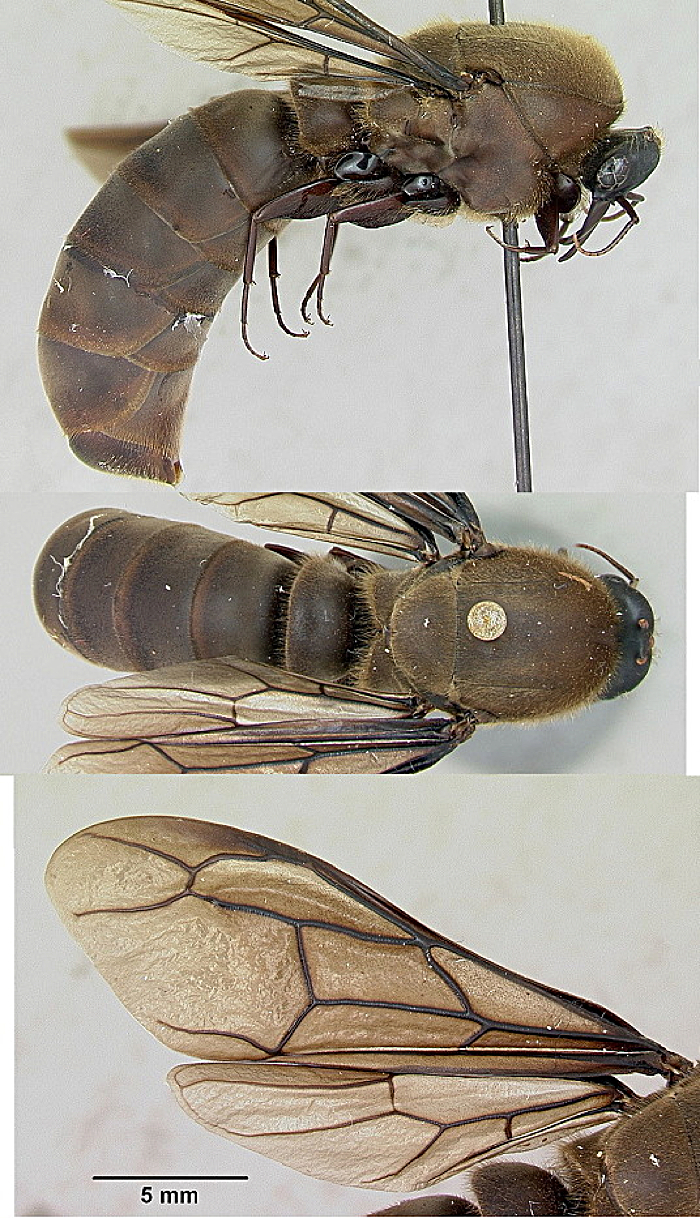 |
. |
| . |  Undescribed but collected with workers in Kenya Undescribed but collected with workers in Kenya |
Primarily from Eastern Africa - molestus |
| Subgenus Anomma introduction |
© 2007, 2009, 2010, 2013 - Brian Taylor CBiol FSB FRES 11, Grazingfield, Wilford, Nottingham, NG11 7FN, U.K. |
href="anomma_males.htm"